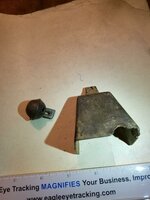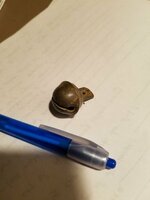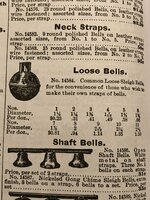In December of 1847, a Dairy farmer in NJ named James was doing the morning count of his herd and noticed one of his best Jerseys was running away though a gate he forgot to close. He grabbed the closest Lasso he could find and ran after the cow. He kept losing sight of the cow because of the rolling terrain but kept following the faint tinkle of it's bell. He thought to himself, "I'm glad I bought all those Crotal Bells from Tom", who was a traveling Crotal Bell salesman from Bellingham Massachusetts. At the end of the first day's chase, he caught site of his cow's silhouette against the setting Sun and noticed they were heading due West. As the Sun went down and it became dark, he no longer heard the sound of the tinkling bell and figured the cow had stopped moving to rest for the night. James, who was also tired from chasing the cow all day, decided to settle down for the night and start a fire to stay warm. He groped around in the darkness and gathered up some dry grass and small twigs to start a fire when it dawned on him that he had nothing to start a fire on him. He heard the sound of footsteps approaching and in the moonlight, could see a native with a string of fresh trout over his shoulder. He asked the native, "Got a light?" while pointing at his pile of grass and sticks. The native nodded and proceeded to rub two of the sticks together until they ignited the grass. While the native was starting the fire, James was looking at the fish and thought how good one of those would taste cooked over an open fire. He reached into his pocket, pulled out a New Jersey Copper coin and pointed at the fish lying on the ground. The native nodded and handed James a trout. As the native was walking away he looked at the strange copper disk he was given, shrugged his shoulders and tossed it into the forest thinking "Kaka".
James was awakened the next morning by the tinkle of the bell and started chasing his cow again. This went on for days which turned into weeks. He noticed the daytime temperature was getting much warmer the further he got from home and the more angry he got at the cow for running from him. Finally on the last day while making his way out of a steep rocky ravine he saw his cow standing about fifty feet away. At this point James was furious at the cow and decided to try and knock it out with a well placed rock. He bent down, picked up what he thought was an abnormally heavy gold colored rock, threw it at the cow only to miss it's head and knock the Crotal Bell from it's collar. He picked up another heavy gold colored rock and this time hit the cow behind it's ear. The cow fell to the ground dead and James thought to himself, "I'm going to gather some of these strange deadly rocks and bring them home in case more cows decide to run away!" On his long journey home, he stopped in different towns for lunch and dinner while paying with large one cent copper coins. Almost everyone he met during meals was a farmer like himself and the talk often was about unruly cows. He showed the strange gold colored rocks to the farmers while telling his story about how these rocks could stop a cow in it's tracks. They asked where he found them and he drew maps for them on napkins. James often found himself alone before finishing his meals and whenever he walked outside would notice clouds of dust heading West.
That' a great find !!






 .
. To each his own, eh ?
To each his own, eh ?  But for those of us who are trying to date them : Solf romantic music, low lights, a bottle of wine, watch a romantic movie, etc.... Eh ?
But for those of us who are trying to date them : Solf romantic music, low lights, a bottle of wine, watch a romantic movie, etc.... Eh ? 
 Did you write that ? If so : You get the creative writing award of the day
Did you write that ? If so : You get the creative writing award of the day 


